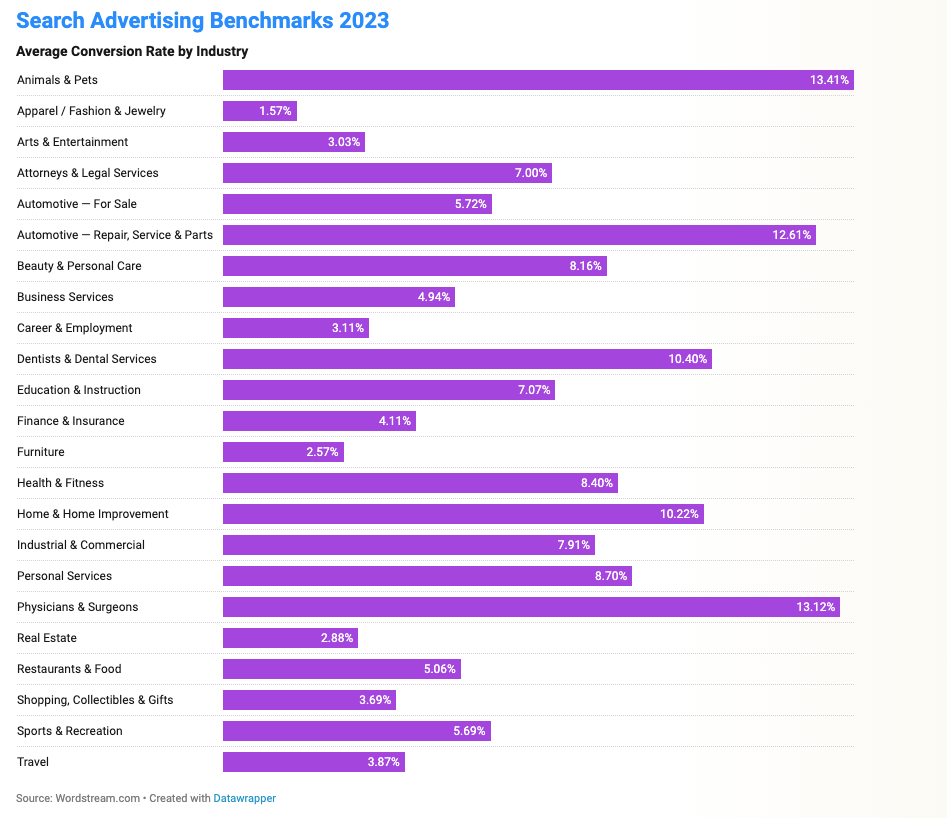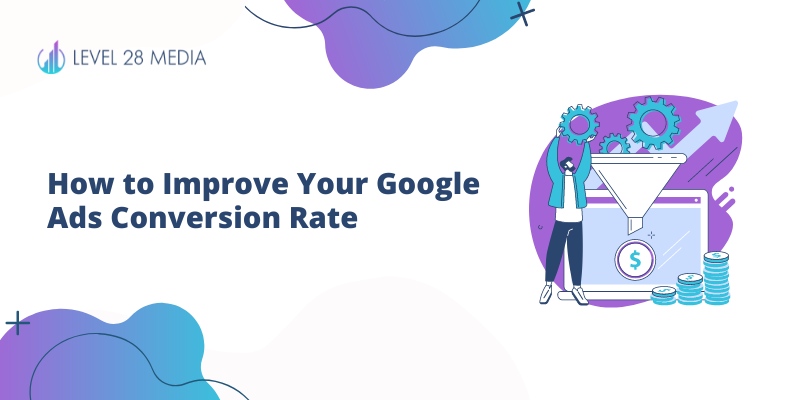If you’re scratching your head wondering what this “conversion rate” metric is all about, no worries, we’ve got you covered! It’s a crucial metric that can make all the difference in the success of your Google Ads campaigns.
In this article, we will uncover five tactics that can help increase your conversion rates and get you more leads from your Google Ads campaigns!
What is a Good Conversion Rate for Google Ads?
Your conversion rate is one of the most important Google Ads (and for any other PPC campaign) metrics to monitor.
The conversion rate is calculated by dividing the number of conversions (desired actions taken by users, such as purchases or sign-ups) by the total number of ad clicks and then multiplying the result by 100 to get the percentage.
Industry benchmarks can be a helpful starting point for gauging your performance. However, it’s important to recognize that there isn’t a universal, one-size-fits-all benchmark for conversion rates as they vary significantly across industries and ad types.

It’s equally crucial to consider your cost per conversion in addition to your conversion rate. A high conversion rate may appear impressive, but if the cost of each conversion is excessively high, your ROI could be compromised.
When assessing your conversion rates, be cautious of overinflated numbers resulting from poor conversion tracking configurations. Inaccurate tracking can lead to false positives, making your conversion rate appear better than it actually is.
How to Improve Google Ads Conversion Rate
1. Beef Up Your Copy
Improving ad copy is one of the best ways to boost conversion rates!
When crafting ad copy, it’s essential to empathize with the audience and address their pain points directly. Do this for both the ad itself and any landing page copy!
By identifying their needs and offering solutions, the copy can resonate more effectively, driving higher click-through rates. Additionally, creating a sense of urgency can motivate users to take immediate action and increase the likelihood of conversions.
With landing page copy, many advertisers make the mistake of writing lengthy paragraphs. Lengthy paragraphs can be overwhelming and deter potential customers from engaging with the content. Clarity and conciseness are crucial in landing pages just like with the ad itself.
Use bullet points, subheadings, and shorter paragraphs to make the content skimmable and visitors will be able to grasp essential information quickly. In addition, visitors are more likely to stay on the page and proceed to the desired call-to-action.
2. Be Strategic With Your Landing Page
A well-optimized landing page can significantly improve conversion rates, particularly for emergency and local service-based businesses. With a landing page, you can add design elements to mitigate exit rates.
Some best practices are:
- Eliminating external site navigation ensures that users stay focused on the intended action
- Minimizing slow page loading times.
- Strong and strategically placed call-to-action buttons.
- Creating a mobile-friendly landing page design
- Establishing credibility through testimonials, reviews, or certifications.
If you are in a business where the customer purchasing journey is more extensive, then it’s worth testing to see if you can use your website as a landing page. Many SaaS companies benefit a lot from using their homepage since it’s already built for conversions.
3. Target Higher Intent Keywords
Here’s the deal: not all keywords are created equal. Some people who are ready to whip out their credit cards and convert are likely using different search terms than those who are just casually browsing around.
Now, if you’re running a service-based business, going after those broad or low-intent keywords might lead to lackluster conversion rates. Why? Well, because those customers might just be starting their research journey and not quite ready to commit.
For instance, let’s say you are a plumber and target the keyword “how to fix a leaky faucet.” DIYers are most likely to use these keywords and they may not be ready to call a plumber yet. It is a low-intent keyword because it’s research-based.
To increase your chances of conversion (and get the most out of your budget), target higher intent keywords like “emergency plumber near me” or “plumber Orange County CA.” When folks are typing these gems into their search bar, you know they are actively seeking a plumber!
So, remember, it’s all about understanding your audience and meeting them where they are in their buying journey.
4. Test Offers
Offers are a great way to stand out from the crowd and give your potential customers that extra push they need to hit that CTA button.
Take a peek at what your competitors are offering, and then get creative. Think outside the box! Can you offer financing options, a free quote, or even a warranty? How about throwing in some comparison tools to help your customers make their decision?
However, don’t cheapen your business with steep discounts. Remember, the goal is to push those potential customers over the finish line, not give your service away for free. That might even attract the wrong customers!
Try A/B testing offers to see what resonates with your target audience. Implement ad copies with different offers and include the offers in your landing page copy.
5. Consider The Customer Experience When Creating Your Form
Finding that delicate balance between the information you need and what your customers are willing to share is important for your forms.
Short lead forms are a marketing preference – they’re quick, easy to use, and won’t overwhelm potential leads. However, don’t be surprised if your sales team nudges you towards longer forms for better prospect qualification. While longer forms may help them, it could also lead to a dip in your conversion rates.
The key is to identify the essential information you truly need. Keep it concise, focusing on crucial details like contact information. For local service-based businesses, don’t go overboard with lengthy forms. After all, someone looking for a nearby plumber doesn’t need to fill out a 12-step form.
A SaaS company would need a more extensive form to deter unserious prospects. You need to understand your ideal customer to build the correct form.
Always prioritize user experience – the smoother the form-filling process, the higher your chances of conversions.
Final Thoughts on Google Ads Conversion Rates
Increasing your conversion rates will take some experimentation and patience! PPC magic isn’t a thing – conversions won’t always increase immediately.
You may need to implement all of these tips (and more) to see results, or you may need to make small tweaks to your current campaigns.
Testing strategically and watching your account carefully will yield the best results!

Michelle Kop is a marketing consultant and award-winning pay-per-click marketing strategist. She has over 8 years of professional paid advertising experience in Google and Microsoft Ads, with a specialization in lead generation for B2B and B2C companies.
After working in corporate marketing with Fortune Global 500 Brands like Toyota and BP, Michelle founded Level 28 Media, a lead generation micro-agency for small to medium businesses.

